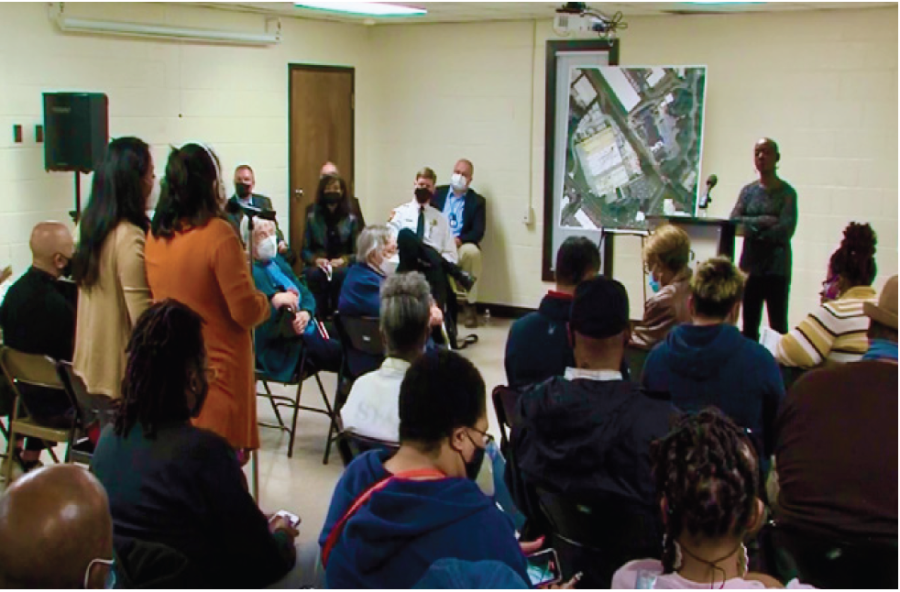Weaver fire reveals environmental racism
Winston-Salem residents face challenges recovering in the wake of the Weaver fire
Winston-Salem residents voice their concerns at a City Hall meeting regarding health, financial, and environmental issues in the aftermath of the Weaver fire. According to the Winston-Salem Journal, 81%-85% of residents near the blaze were people of color.
February 24, 2022
The fire that erupted at the Weaver Fertilizer Plant came as a surprise to many, yet an investigation into the racial history of Winston-Salem reveals a pattern of environmental inequity that affects the lives of both Winston-Salem residents and Wake Forest students alike.
On the evening of Monday, Feb 1. a fire ignited at the north end of the Weaver Fertilizer Plant and spread rapidly, leading city officials to urge the roughly 6,500 residents within a one-mile radius of the fire to evacuate their homes. Although Wake Forest’s campus is situated outside of the endangered zone, its proximity to the blaze provoked many students to stay at nearby hotels, the homes of friends outside the city.
The privilege of an easy evacuation that many Wake Forest students had was not shared by most local residents as they left their homes Monday evening. At a Winston-Salem City Hall meeting on the evening of Thursday, Feb. 17, one local resident spoke of having to move her disabled mother out of their home, along with her wheelchair and multiple days’ worth of clothes.
North Hills Elementary school was also within the one-mile radius of the fire. Its learning went virtual for Tuesday and Thursday during the week of the fire, leaving many parents without childcare and kids without proper learning assistance.
Wake Forest English Professor Dr. Dean Franco specializes in comparative race studies within his department. A Winston-Salem local, Franco is familiar with the community near the Weaver plant and was able to relate the tragedy of the fire to other instances of racial inequity he had studied in his academic career. “Even if a fertilizer plant existed before the development of residential housing in the neighborhood around Weaver, there ought to be some way of mandating that that industrial plant follow some kind of regulations that makes it safe for the residents.” Franco said. “There was a clear discrepancy between the experience of those residents and the experience of Wake Forest students with relation to the fire.”
As students returned to campus over the weekend following the fire, residents were still left with many concerns for both their physical and financial wellbeing. Chemical runoff from the fire has affected the nearby Muddy, Mill and Monarcas creeks. Although air quality near the plant has returned to safe breathing levels for residents, many are still concerned about the particulate matter from the fire leaching into their food, clothing, countertops and soil.
While the thousands of evacuees that were urged to evacuate their homes have returned, many have been left with financial burdens after being away from home for nearly a week. The fire prevented many residents from being able to go to their jobs, either because their occupations were within the mile radius of the blaze or because they didn’t have access to the necessary transportation. Love Out Loud, a local nonprofit, has been accepting donations to distribute to those affected.
Concerns have been raised, however, that residents are not being adequately financially assisted by Love Out Loud’s relief efforts.
“The non-profit is requiring receipts from residents for reimbursement,” Dr. Corey Walker, head of Wake Forest’s African American studies program said. “If you go to stay with your mom and eat her food and use her water and electricity for that week, how can you prove what you consumed in receipts?”
Furthermore, as Walker pointed out, seeing low-income, primarily African American residents affected by industrial environmental tragedy is not an uncommon or new phenomenon. Although the Weaver Fertilizer Plant was built before the residential homes surrounding it, the value of properties close to the fertilizer plant is significantly lower than other neighborhoods in Winston-Salem. These homes are affordable to people who work in lower-income jobs and are predominantly communities of color.
“The proximity of the affected communities to Weaver isn’t just some isolated happening. If you start to look at the history of Winston- Salem, you can see a land-use pattern develop, going all the way back where Negro tenements were located in relation to the railways passing through Winston.” Walker said.
Crystal Dixon works on Wake Forest’s President’s Committee for Race, Equity, and Inclusion. Over the past couple of years, she has worked with academic departments to define what it means for each of them to make equitable progress, whether that be opening up conversations about race, being more aware of diversity on campus, or holding events to educate students about Black history.
She also collaborates with the Office of Diversity and Inclusion to coordinate engagement between Wake Forest and the surrounding Winston-Salem communities. In a class she teaches on the intersection between race and sustainability, she asked her students to consider what it would be like to experience tragedies like the Weaver fire consistently.
“I said, ‘you all were panicking for five days of the Weaver situation, imagine living in that kind of situation for an entire lifetime.”’ Dixon said. “It’s no coincidence these people live here either, they’ve been targeted. Since the 1930s, a practice called redlining has placed certain communities near toxic environmental conditions because the property values are lower and they are cheaper places to live, but they are also really the only affordable places to live for under-resourced communities to live.”
Professor Dixon also mentioned that, while it’s good to be aware of the environmental inequity surrounding the Weaver situation, the next step is spreading that awareness to others.
“Wake Forest is very much in our own little bubble.” Dixon said. “It would be great if we had some kind of immersion experience for Wake Forest students, just so they could walk around N. Cherry St. or the Boston-Thurmond neighborhood and experience what life is like less than a mile away from campus.”
Franco agrees. “There is moral blindness in bringing students to campus and not educate them about their surroundings,” he said. “The Wake Forest community ought to start understanding that it has obligations of reciprocity and mutuality with its proximate neighbors, including the residential community just north of campus that was displaced by the fire.”
Furthermore, Dixon explained that, while being aware of environmental racism is important, it’s entirely different to live it every day. “It’s not enough to volunteer at places like Campus Kitchen or somewhere on-campus. You really need to go breathe the air those people breathe, see and experience what their life is like, to develop the necessary empathy needed to understand inequity.”














Jake Casey • Apr 14, 2022 at 5:21 pm
Blame blame blame. As the article points out those homes were built after that fertilizer factory was there. What About those students who lived 300 yd down wind from the plant? Did that inflict racism upon them? Victimhood doesn’t improve people’s plight it just makes them angry and adds to our already toxic culture. The 2 biggest ways to get people out of poverty is 1. not having children until you’re married and 2. finishing high school.
Blaming people and calling them a racist when they weren’t even born when red lining occurred is unfair.
Rose • Feb 26, 2022 at 3:53 pm
Good job students for bringing up this important topic – history of NC is riddled with environmental racism. The term itself was born in Warren County NC in the 1980s. Effects of redlining and the segregation of our community since the construction of US-52 are still affecting us today.
Joe low • Feb 24, 2022 at 1:38 pm
Professor is just stirring the pot! Should be fired!
bob • Feb 27, 2022 at 5:10 pm
bruh what you mean